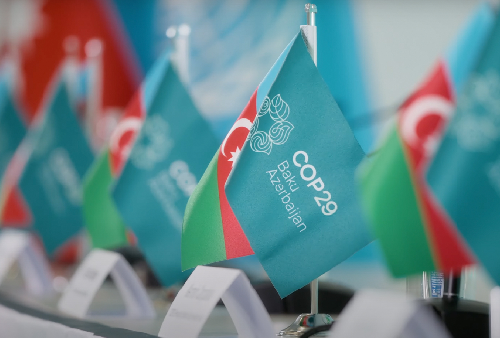As we approach COP29 in Baku, Azerbaijan, Africa’s voice in the global climate dialogue becomes increasingly crucial. The groundbreaking commitments made at COP28 in Dubai have opened new pathways for climate action, with climate finance emerging as the decisive factor in Africa’s climate resilience journey.
COP28 Outcomes: One Year Later
The impact of COP28 decisions is becoming increasingly apparent:
- Loss and Damage Fund: In its first operational year, the fund has disbursed $1.2 billion to vulnerable countries, with African nations receiving 40% of the allocations.
- Renewable Energy Capacity: Global renewable energy capacity increased by 18% in 2023, reaching 3,400 GW, according to the International Renewable Energy Agency (IRENA). This puts the world on track to meet the COP28 goal of tripling capacity by 2030.
- Fossil Fuel Transition: Investment in fossil fuel projects decreased by 12% globally in 2023, while clean energy investments saw a 23% increase, as reported by the International Energy Agency (IEA).
The Evolving Landscape of Climate Finance in 2024
The past year has also seen significant shifts in the climate finance landscape, influenced by global economic trends and the increasing urgency of climate action.
- Global Climate Finance Flows: According to the latest Climate Policy Initiative report released in early 2024, global climate finance flows reached $850 billion in 2022/2023, marking a 34% increase from 2019/2020 levels.
- Progress on the $100 Billion Goal: The OECD’s most recent data shows that climate finance provided and mobilized for developing countries reached $96.5 billion in 2023, tantalizingly close to the long-promised $100 billion annual target.
Climate Finance Across Economic Sectors: A snapshot of 2024
Energy Sector
- Investment Trends: Clean energy investments reached $1.8 trillion globally in 2023, with projections indicating a further 15% increase in 2024.
- African Context: Africa’s renewable energy investments grew by 30% in 2023, reaching $60 billion. Solar projects account for 45% of this investment, driven by falling technology costs and supportive policies.
Agriculture
- Climate-Smart Agriculture: Global investments in climate-smart agriculture reached $35 billion in 2023, a 75% increase from 2019/2020 levels.
- African Green Revolution: The African Development Bank’s (AfDB) Climate-Smart Agriculture program has supported 20 million farmers across 30 countries as of 2024, increasing yields by an average of 40% while reducing emissions.
Transportation
- Electric Mobility: Global electric vehicle sales surpassed 14 million units in 2023, with Africa seeing a 150% year-on-year increase, albeit from a low base.
- Sustainable Urban Transport: Lagos, Nigeria’s Blue Line light rail, operational since late 2023, has reduced daily CO2 emissions by 30,000 tons and cut commute times by 50% for 400,000 passengers.
Manufacturing
- Circular Economy: The Ellen MacArthur Foundation reports that circular economy initiatives could generate $4.5 trillion in economic output by 2030, with Africa poised to capture $500 billion of this value.
- Green Manufacturing: South Africa’s Green Industries Incentive has catalyzed $2.5 billion in green manufacturing investments in 2023, creating 15,000 new jobs.
Finance and Banking
- Green Bonds: The global green bond market reached $900 billion in 2023, with African issuances growing by 80% to reach $15 billion.
- Blended Finance: The Convergence platform reports that blended finance transactions in Africa reached $8 billion in 2023, a 60% increase from 2022.
Unlocking Prosperity for Africa: 2024 Perspectives
Job Creation
- IRENA’s 2024 report projects that renewable energy could employ 6 million people in Africa by 2050, up from previous estimates due to accelerated adoption rates.
- The International Labour Organization’s latest data shows that green jobs in Africa grew by 25% in 2023, outpacing overall job growth.
Economic Growth
- The African Continental Free Trade Area (AfCFTA) Secretariat reports that green trade within Africa increased by 40% in 2023, contributing an additional 1.5% to continental GDP.
- Climate-resilient infrastructure investments in Africa reached $50 billion in 2023, with every dollar invested expected to yield $4 in benefits, according to the Global Center on Adaptation.
Enhanced Resilience
- The Africa Adaptation Acceleration Program (AAAP) has mobilized $25 billion for climate adaptation projects as of early 2024, benefiting 30 million people across 20 countries.
- Early warning systems, now covering 60% of Africa’s population (up from 40% in 2022), have reduced climate-related economic losses by 30% in affected areas.
Challenges and Opportunities in 2024
Despite progress, significant challenges remain:
- Access to Finance: While improving, Africa still only receives 5% of global climate finance flows as of 2023, up from 3% in previous years.
- Adaptation-Mitigation Balance: Adaptation finance in Africa has grown to 25% of total climate finance on the continent, but still falls short of the 50% goal set by many African countries.
- Private Sector Engagement: Private climate finance in Africa grew by 40% in 2023 but still accounts for only 20% of total climate finance on the continent.
The Road to COP29: Africa’s Priorities
As COP29 approaches, key focus areas for Africa include:
- Pushing for the full implementation of the Loss and Damage Fund, with streamlined access for vulnerable communities.
- Advocating for increased adaptation finance, aiming to reach the 50/50 split between adaptation and mitigation.
- Developing an “African Green Deal” that aligns climate action with economic development goals.
- Promoting innovative financing mechanisms, such as the newly launched African Carbon Markets Initiative, which aims to produce 300 million carbon credits annually by 2030.
Conclusion
As we stand on the threshold of COP29, the data paints a picture of both progress and persistent challenges in climate finance for Africa. The continent is showing remarkable resilience and innovation in leveraging climate finance for sustainable development. However, the scale of the climate crisis demands even greater ambition and resource mobilization. The year 2024 has demonstrated that when climate finance is strategically deployed, it can be a powerful catalyst for green prosperity.
As African leaders prepare to make their case at COP29, they do so armed with compelling evidence of the continent’s potential to lead in the global green economy. The challenge now is to translate this potential into reality, turning climate finance from a promise into a transformative force for Africa’s sustainable future.






